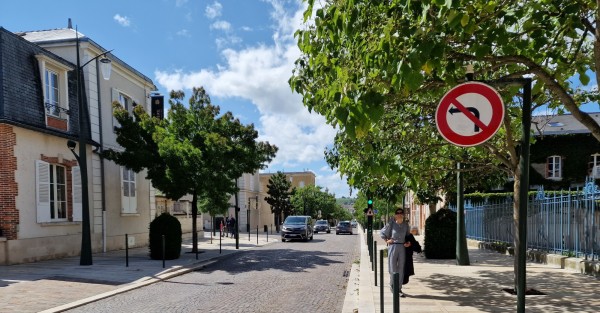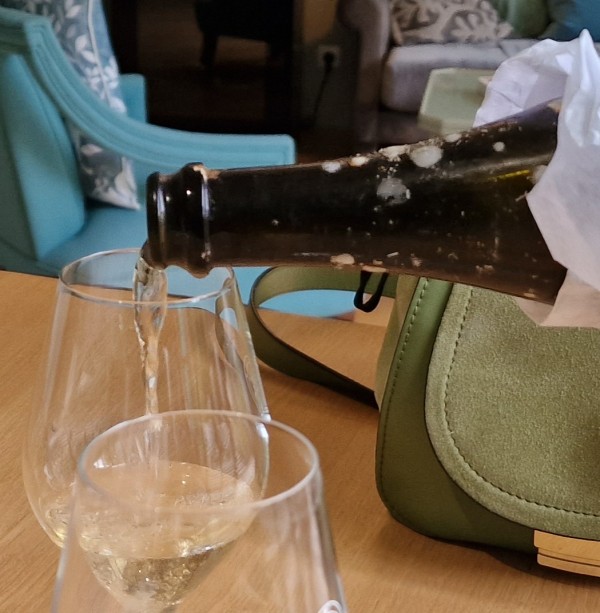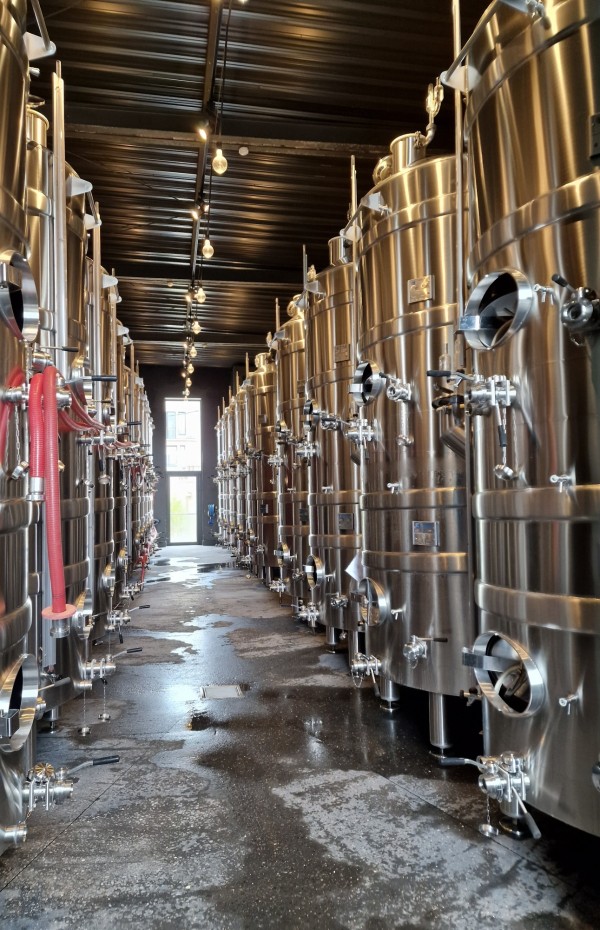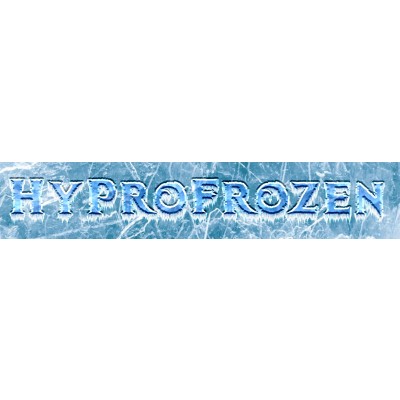The Magic of Champagne

Enzo Sisto 9 augustus 2023

The Magic of Champagne
During the 17th century, the Champagne region of France was already well-known for its wine production, but the wines were predominantly still and tended to have some undesirable characteristics, such as cloudiness and an unappealing taste. Dom Pierre Pérignon played a crucial role in elevating the quality of wines from this region. The world's most famous French champagne brand takes its name from him.
As a "professional" monk and a passionate enologist, Pérignon devoted himself to the vineyards of the Hautvillers Abbey, located in the Champagne region of France, where he entered as treasurer and manager in 1668. Among his responsibilities was the care of the vineyards, a task that he deeply enjoyed. At his death, Dom Pierre left behind twenty-four perfectly maintained hectares of land that produced wines of good quality and were highly appreciated. Through his winemaking expertise, he managed to improve the abbey's finances significantly.

Legend has it that Champagne was not the result of a deliberate experiment but rather an accidental discovery. The Benedictine monk noticed that some bottles of wine left in the cellar to mature had burst. Dom Pérignon had initially come up with the idea of sealing the bottles with beeswax to ensure an airtight closure. However, after a few weeks, due to the excessive pressure, the bottles would explode, and it was in this manner that Pierre discovered the "méthode champenoise."
Pierre Pérignon's contributions to winemaking extended beyond the development of sparkling wine. He also promoted the use of thicker glass bottles, cork stoppers, and wire cages to prevent the bottles from bursting during fermentation, thus making the production of Champagne more reliable and safer. He experimented with blending different grape varieties, improved vineyard management practices, and explored various winemaking processes. Through his observations and dedication, he made significant advancements in the production of Champagne.
Today, the legacy of Dom Pierre Pérignon continues to live on, and his name is synonymous with excellence in Champagne production. The Champagne house bearing his name honors his memory and maintains a commitment to producing top-quality sparkling wines that carry on the tradition he helped establish over three centuries ago.
Epernay and his gourmet champagne pairing.
Epernay can be considered the capital of the Champagne.

Once upon a time, in the enchanting town of Épernay, nestled in the heart of the Champagne region, there stood a grand boulevard known as the Avenue de Champagne. This magical avenue was a treasure trove of exquisite champagne houses, each with its own story to tell.

The first house on the avenue was Moët & Chandon, an ancient establishment that bore witness to centuries of champagne-making expertise. Its origins traced back to 1743, where a young entrepreneur named Claude Moët had a bold vision of sharing the joy of champagne with the world. Here below Chateau Moët & Chandon:

The house flourished, and its signature cuvées, including the legendary "Dom Pérignon," became synonymous with luxury and celebration.
Further down the avenue, the Perrier-Jouët house exuded an air of elegance and beauty.

Founded in 1811, it was a sanctuary of floral champagnes, where a passion for art and nature was woven into the very fabric of their offerings. The ethereal Belle Époque cuvée, adorned with delicate white anemone flowers, was the epitome of refinement.

Nearby, the Pol Roger house stood tall and proud. With its history dating back to 1849, it had gained fame as the champagne of choice for the great statesman, Sir Winston Churchill. The deep cellars beneath the house whispered tales of craftsmanship and dedication, as generations of winemakers perfected their art to create champagne fit for royalty.

As visitors strolled along the avenue, they found themselves drawn to the Mercier house, a beacon of accessibility and innovation since 1858. The house's grand cellars were a marvel to behold, and an exciting "train experience" awaited those eager to explore the underground labyrinth. Mercier's diverse range of champagnes appealed to all, making it a beloved choice for those seeking both tradition and modernity.
Finally, the BOIZEL house stood as a testament to family heritage and excellence. Since its inception in 1834, the Boizel family had poured their heart and soul into crafting champagnes of consistent quality and sophistication. Their bubbling creations mirrored the spirit of Épernay, where tradition, heritage, and innovation intertwined seamlessly.
The Champagne region is a treasure trove of diversity and craftsmanship, boasting over 340 distinct champagne brands that each carry their own unique story and character. The rich tapestry of flavors, terroirs, and traditions woven into these champagnes is a testament to the artistry and dedication of the vintners who have honed their craft for generations.

As the sun set over the Avenue de Champagne, a sense of magic lingered in the air. The houses, each a chapter in the storied history of champagne-making, illuminated the night with their brilliance. The boulevard sparkled with laughter, clinking glasses, and the joy of celebration.

Plates of delicate oysters, their briny essence harmonizing with the wine's acidity, were passed around, leaving smiles of delight on the faces of those who tasted them.
Next came platters of creamy brie and aged Comté cheese, the velvety textures and nutty flavors forming a perfect marriage with the lightness of the bubbly. The guests relished every bite, savoring the exquisite pairing that enhanced the wine's complexity.
As the evening progressed, the feast continued with tender slices of smoked salmon and flaky puff pastry, accompanied by the delicate floral notes of the champagne. The sparkling wine seemed to dance with joy, celebrating the union of flavors on each plate.
In the midst of the celebration, a renowned chef emerged from the crowd, a twinkle in his eye. He had a surprise in store for the guests - a culinary masterpiece designed to elevate the champagne experience to new heights. With the expertise of a maestro, he prepared a dish of succulent veal cheeks, slow-cooked to perfection, and garnished with a drizzle of velvety truffle sauce.
As the guests tasted the veal, they were transported to a realm of gastronomic bliss. The rich flavors of the meat intertwined with the champagne, each sip enhancing the nuances of the dish. It was a symphony of taste, a crescendo of delight that left everyone speechless.
The night continued with more culinary delights, from delicate foie gras to exquisite chocolate truffles, each dish carefully crafted to harmonize with the champagne's unique character. The guests reveled in the magical pairing, each bite a testament to the culinary artistry of the region.

Champagne and meat pairing.
The freshness and vivacity of champagne make it an ideal companion for various meat-based meals.
Several reasons contribute to the compatibility of champagne with meat:
- Acidity: Champagne's acidity helps cut through the richness and succulence of meat, especially fatty cuts like veal kidneys and cheeks. The wine's acidity cleanses the palate after each bite, preparing it for the next.
- Bubbles: The champagne's bubbles act as a natural palate cleanser, enhancing the taste of the meat and improving the overall gastronomic experience.
- Versatility: Champagne is a versatile wine that harmonizes well with delicate and robust flavors alike, making it suitable for various meat preparations like veal kidneys, cheeks, and sweetbreads.
- Flavor Contrast: Pairing champagne with meat-based dishes creates an interesting contrast between the rich, meaty taste and the freshness and lightness of the bubbles.
By experimenting with different combinations, one can discover personalized pairings that suit individual preferences and the type of meat prepared. It is essential to serve champagne at the proper temperature, usually between 7°C and 12°C, to fully appreciate its qualities during the meal.
Furthermore, renowned French chefs with Michelin stars have successfully crafted exquisite champagne pairings with veal-based dishes. Some notable names include Alain Ducasse***, Anne-Sophie Pic***, Emmanuel Renaut***, Yannick Alléno***, and Guy Savoy**. These chefs' dedication to culinary innovation and their expert combinations of champagne and veal dishes offer unforgettable gastronomic experiences at their acclaimed restaurants.
Napoleon Bonaparte and his generals loved it.
In the midst of the vibrant Champagne region, where the art of celebration and mastery of craftsmanship converged, a timeless legend emerged—the legend of the sabre. With a history woven through the fabric of Napoleon's era, this captivating tale harkened back to the days when generals and officers reveled in the art of opening champagne bottles with a swift and elegant swipe of their sabres.
As the story goes, in the midst of grand gatherings and triumphant victories, Napoleon's generals found themselves faced with an exquisite challenge—how to open champagne bottles in a manner befitting their stature and panache. Fueled by their audacious spirit, these military leaders discovered a unique way to turn an ordinary act into a theatrical display of finesse and courage.

For the gourmets:
Veal Kidneys: An excellent combination would be a Brut or Extra Brut champagne. The acidity of these champagnes complements the distinct flavor of veal kidneys, while the bubbles cleanse the palate between bites.
Veal Cheeks: Veal cheeks often have a tender texture and intense flavor. To balance this richness, a Blanc de Noirs champagne, produced mainly with black grapes like Pinot Noir, can be an excellent choice.
Veal Sweetbreads: Sweetbreads have a delicate and creamy taste. To highlight this characteristic, a Blanc de Blancs champagne, made exclusively with Chardonnay grapes, adds an elegant freshness to the dish.

How It's Made
In the enchanting region of Champagne, the harvest takes place in September, precisely 100 days after the vine blossoms. Meticulously hand-picked, the grapes are treated with utmost care to avoid any damage and ensure that only the finest bunches are chosen, leaving behind any rotten ones.

Once the best bunches are selected, the journey of crafting champagne begins, a process comprising several key stages:
Pressing:
Champagne production involves a specific and delicate process of grape pressing to extract the juice, which is the foundation of the sparkling wine. The pressing is carried out in multiple stages, each with its own purpose and characteristics.
- First Pressing (Cuvée): The initial pressing, also known as the "Cuvée," is the most valuable and produces the highest quality juice. It involves gently pressing whole clusters of grapes to extract the free-run juice. This juice is known for its purity and finesse, and it forms the base for the premium champagne blend.
- Second Pressing (Taille): After the first pressing, the remaining grape solids, known as "pomace," are subjected to a second pressing. This pressing is called the "Taille." While the juice obtained is of slightly lower quality compared to the Cuvée, it still contributes to the overall blend. Sometimes some producers known a first and second “taille” to be more accurate when they have to (need to) blend it with the Cuvée.
- Third Pressing (Rebêche): Following the second pressing, a third pressing known as "Rebêche" can be performed. This press yields even lesser-quality juice, and it is typically used for producing lower-grade sparkling wines or for distillation purposes.
Champagne houses often use a combination of these pressings to create a balanced and consistent blend. The juice obtained from each pressing is meticulously classified and stored separately to maintain traceability and precision during the blending process.
It's worth noting that modern champagne production often utilizes modern presses that are gentle on the grapes, allowing for more control over the extraction process. Traditional basket presses were historically used, but nowadays, modern membrane presses are commonly employed, ensuring efficient and gentle juice extraction.
The quality of the grape pressing is a critical factor in determining the ultimate character and flavor profile of the champagne, making it a crucial step in the complex and fascinating art of champagne production.

Fermentation:
The pressed grape must is placed in vats for an average of 15 days, kickstarting the first "alcoholic" fermentation. Natural yeasts present in the grape juice come to life, converting sugars into a delightful blend of alcohol and carbon dioxide.

Clarification
This step involves removing any yeast or other solid particles that may affect the wine's flavor.
Winemaking and Blending
During this classic winemaking stage, the vintner mixes still wines, skillfully combining various parcels with different grape varieties and from different years.

Bottling and Second Fermentation
The still wine is bottled, and the liqueur de tirage (a mix of sugar and yeast) is added to initiate the second fermentation. Yeast transforms sugar into alcohol, generating carbon dioxide, and thus the "mousse" or bubbles. The bottle is then sealed with a special stopper.
Aging on Lees
The champagne matures on its lees for at least 15 months (as per regulations) from the time of bottling to shipping, and for vintage champagnes, it's aged for three years.
Riddling
The bottles are placed on inclined racks, and the second fermentation in the bottle creates sediment – the spent yeast cells. To clarify the champagne, the bottles are turned and tilted over several weeks, causing the sediment to gradually descend towards the bottle's neck.
Disgorging
The sediment is expelled through a process involving a cold brine bath (-25°C), after which the loss is replenished with the "liqueur d’expédition," which determines the champagne's final sweetness level (Brut nature, Extra-Brut, Brut, Sec, Demi-Sec, etc.).
Corking and Finishing
The bottle is then ready to receive its cork, wire cage (muselet), label, and foil, completing the champagne's elegant presentation.
The Mystery of Bubbles
How magic? ...experience it in the Perrier-Jouët garden looking at this video.
Champagne is the result of blending several already fermented wines, crafted from three grape varieties: chardonnay, pinot noir, and pinot meunier. Once these wines are artfully combined, a liqueur de tirage – composed of wine, yeast, and sugar – is added before bottling and capping. The liqueur de tirage triggers a second fermentation, releasing carbon dioxide that gets trapped in the bottle, forming bubbles.
Fine bubbles are considered a mark of excellence by experts and connoisseurs alike. Why?
The sight of slender columns of fine bubbles is more appealing than large, heavy, and slow bubbles.
As the bubbles rise, they carry with them a rich array of aromas, contributing to the wine's bouquet and complexity.
Gentle bubbles stimulate sensory receptors in a way that engages our senses.
Sommeliers favor wine glasses shaped like rugby balls. The height promotes bubble ascent, the broad bowl allows the aromas to develop fully, and the narrowed opening prevents their quick escape. To preserve bubbles, investing in a specialized champagne stopper is ideal, keeping your champagne effervescent for up to 48 hours.
Three Dominant Grape Varieties
The grape varieties used play a crucial role and have an evident impact on the wine's taste.
Chardonnay: Occupying 30% of the vineyards, Chardonnay is characterized by delicate aromas, floral notes, and hints of citrus. It is the ideal grape for wine aging.
Pinot Noir: Representing 38% of the vineyards, Pinot Noir offers aromas of red fruits, adding structure and power to the blend.
Pinot Meunier: Accounting for 32% of the vineyards, Pinot Meunier contributes to creating supple and fruity wines, lending a rounded aspect to the final blend.

1872 The House of Leclerc Briant

It has been a great experience to be guided in the singular universe of Leclerc Briant. The House opens its doors for intimate visits and will reveal the particularities of our biodynamic Champagnes during the tasting. I have been invited to be there.
The House of Leclerc Briant (Address : 67 Chemin de la Chaude Ruelle, 51200 Epernay) stands as a beacon of innovation and reverence for nature in the Champagne region. Founded in 1872 by Lucien Leclerc in the picturesque village of Cumières, the business moved to Epernay in 1955, led by the dynamic Bertrand Leclerc and his wife, Jacqueline Briant. It was during this time that the estate transitioned into a Maison de Negoce, embracing a new chapter of growth and development.

Bertrand Leclerc, the great-grandson of the founder, was a visionary who was captivated by the principles of biodynamics even before it gained widespread recognition. As early as the late 1950s, he advocated for biodynamics and practiced its principles in the vineyards. His passion for these holistic practices was passed down to his son Pascal, the fifth generation of Leclercs, who worked diligently to obtain the first full certifications for biodynamic viticulture.
At Leclerc Briant, a profound respect for nature and the terroirs has always been paramount. With a deep understanding of the interconnectedness between vine, soil, and ecosystem, they embarked on a journey towards organic and biodynamic certifications for their entire vineyard. This commitment to sustainability and harmony with nature is reflected in the finesse and purity of their champagnes.

In the Champagne vineyards, a harmonious experiment unfolded—winemakers embraced nature's wisdom by infusing herbs into the soil. Lavender, rosemary, chamomile, and mint nurtured the vines, resulting in exceptional grapes at harvest.

Inside the cellars, innovation met tradition. From porcelain terracotta to glass and golden-lined stainless steel, diverse containers embraced the champagne's evolution. With time, each vessel imparted its unique touch, preserving the natural fermentation process.

When the corks popped, the result was a symphony of flavors—a testament to the marriage of nature's guidance, human innovation, and the heart of Champagne.

Tasting a glas of "La Cuvée Abyss 2017 BIO 1er Cru."

The House of Leclerc Briant, with its deep respect for nature and biodynamic principles, crafted this exceptional champagne with equal parts of the three principal grape varieties of Champagne - chardonnay, pinot noir, and pinot meunier.
But this Cuvée was more than just extraordinary; it held a remarkable story that would captivate hearts far and wide. The Maison Leclerc Briant had formed an unexpected alliance with the Amphoris Society, experts in underwater exploration. Together, they had a daring idea - to immerse the bottles of this exquisite champagne in the depths of the sea, off the shores of the enchanting Ile de Ouessant in Brittany, for their aging process.
In the mystical depths of the sea, at a depth between 50 and 60 meters, the champagne of Leclerc Briant lay cradled in the cool darkness. A daring experiment that defied convention, the bottles were carefully submerged, guided by the expertise of the Amphoris Society, to age in the embrace of the ocean's mysteries.

As the gentle waves caressed the ocean floor, the bottles of La Cuvée Abyss 2017 BIO 1er Cru found their underwater sanctuary. Here, amidst the aquatic ballet, they became one with the sea, enveloped by its enchanting depths. The pressure at this mesmerizing depth, a formidable 6 bar, mirrored the internal pressure of the bottles, as if the sea itself recognized the champagne's quest for perfection.
In this mesmerizing underwater dance, the champagne embarked on a transformative journey. The ocean's embrace played its part in nurturing the aging process, enhancing the champagne's characteristics with a touch of marine magic. The sea's caress infused the champagne with a unique sense of place, carrying echoes of the briny breeze and the whispers of ancient secrets hidden beneath the waves.
As time passed in the underwater haven, the champagne evolved. The bubbles danced with newfound grace, creating an effervescence that seemed to mirror the playfulness of the waves above. The sea's influence gently shaped the flavors, adding a subtle touch of salinity and a delicate minerality to the already magnificent taste.

Above the ocean's surface, the Maison Leclerc Briant waited with bated breath, eager to unveil the results of this audacious venture. When the time finally arrived, the bottles emerged from the deep, cradled in the arms of divers who had witnessed the enchanting transformation.
With every sip, wine enthusiasts were transported to the underwater realm, where the marriage of the sea and the land unfolded in a symphony of flavor. La Cuvée Abyss 2017 BIO 1er Cru had become a true testament to the harmonious bond between nature's wonders and the artistry of winemaking.
The tale of this sea-aged champagne echoed far beyond the shores of Épernay, drawing admirers from distant lands who were captivated by the romance of its origin. The champagne that had ventured to the depths of the ocean had become a cherished legend, forever etched in the history of the Maison Leclerc Briant.
And so, the champagne aged in the cool darkness of the sea, between 50 and 60 meters deep, continued to captivate hearts and palates alike. A magical encounter with the mysteries of the deep, it stood as a testament to the relentless pursuit of excellence and the boundless possibilities that awaited those who dared to venture beyond convention.
Leclerc Briand, best champagne brand in 2022, is also appreciated by His Excellency the President of the Republic Emmanuel Macron.


I hope you enjoy this short story about the champagne.
After having tasted champagne many times in life it was very interesting to perceive what is hidden behind this excellent product. I sincerely recommend if you have the opportunity to spend a couple of days in Epernay and its surroundings.
Gerelateerde blogs

Filled Fresh Pasta
Enzo Sisto 13 juni 2022
Pasta is divided into two categories: dried pasta (pasta secca) which can be produced commercially and fresh pasta (pasta fresca) which is traditionally produced by hand. Between the two styles, there are over 300 styles of pasta that come with over 1,300 different names.
Fresh filled pasta is the focus of this story

The new IQF 2.0 is HyProFrozen
Enzo Sisto 27 mei 2020
HyperFrozen is the new fresh.
With a Professional touch it became
HyProFrozen™©®: frozen with 3 “PRE”:
We PREpare your fresh food in a professional frozen way.
We PREvent all degenerative processes.
We PREserve it from alteration and waste.

The Real Meat Bastard
Enzo Sisto 28 februari 2018
The count-down is already started. Let us keep in touch: the "Dutch Nationals BBQ Weeks" are arriving.